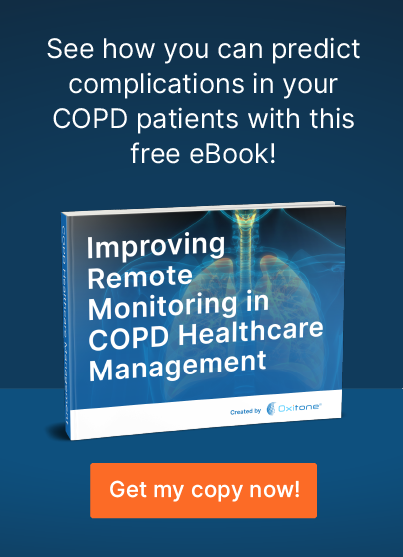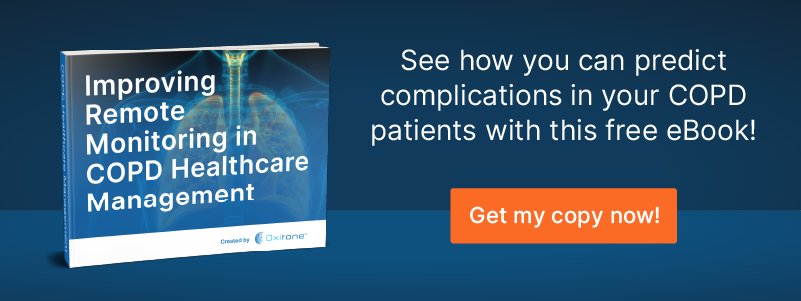Whether it’s regarding medication refills, symptom management, or emergent needs, patients should feel empowered to communicate with their healthcare provider. Part of this empowerment stems from knowledge. Patients may not wholly understand which data points are necessary to share with their provider, and this is understandable, given the years and level of training that precedes this expertise. However, data is essential for determining their current status, as well as knowing the next steps for care. Management of patients with complex conditions requires a nuanced approach that prioritizes continuity of care alongside patient engagement.
COPD is a useful case example for this point. COPD is a significant chronic illness and confers a considerable burden of care for the patient, caregiver, and provider. Physicians who treat patients with chronic illnesses like COPD understand the level of commitment required to ensure patient understanding and adherence to a long-term care plan. The care plan needs to be adaptable to the patient’s needs and other comorbidities as time goes on, but assessing this can be difficult with time and resource constraints.
Data is central in this case because it can provide an objective lens to an overall complicated care flow. It can also support a provider’s hypothesis, provide an explanation for a patient’s concern, and lead to further work-up. However, data collection can itself create a completely new set of appointments and wait times for the patient, causing frustration and delays in care.
Data points are needed during times of stress, as well as times of relatively good health, to understand patterns and trends on a per-patient basis. Traditional remote patient monitoring has relied on the application of siloed tools to provide a discrete data point of a patient’s status. For example, patients with congestive heart failure can be given a blood pressure cuff that allows them to self-monitor at home and share measurements with their provider when requested.
This may be fine for certain diagnoses, but for complex medical conditions that require a series of measurements, it isn’t feasible to expect a layperson patient to perform this complicated round of data collections.
In our digitized world, leveraging existing technology is a more strategic way to solve this problem. Metrics ranging from vital signs to COPD-specific data points can track a patient’s progress over time, which allows the provider to streamline the assessment and planning portion of the visit.
Remote monitoring is not as action oriented as other solutions. Traditional remote monitoring systems provide discrete data points that aren’t meaningful unless knitted together to create trends. But there’s a solution that leverages intelligent technology to collect data in a continuous manner.
A continuous patient monitoring device, which includes wearable technology, is a patient-centered solution that achieves this aim. For COPD patients, assessment of oxygen status is crucial, alongside vitals. Many patients may not know how to effectively collect or communicate this data to their provider. A wearable device removes the burden of constantly updating their provider via an electronic medical record or other patient-provider communications. CPRM solutions, like one-click real-time clinical continuous data access enabled for hypoxia index, can meet this need, especially for COPD patients.
Here are the other data points that Oxitone integrates that are important for COPD and chronic lung diseases:
- Respiratory rate
- Blood oxygen SpO2
- Pulse rate and HRV
- Hypoxia index
- Physiological stress
Along with furthering individual patient outcomes, continuous patient monitoring solutions support efforts to reduce hospital readmissions. Centers for Medicare & Medicaid Services studies have shown that Medicare beneficiaries with COPD sustained healthcare costs $15-20K higher than those without COPD and that the majority of these costs were from hospital admissions. Acute-on-chronic COPD exacerbation is a major risk factor for hospital readmission, which can be heavily disruptive to a patient’s self-management of their chronic health condition, as well as their recovery and baseline status.
Continuous wearable devices for patients can help providers assess patient status on a real-time basis, easily integrating into the provider’s native system via secure API. The Oxitone system has a “smart notifications” system in place, ensuring that providers can focus on the patients most in need at that time. For those with COPD, the system is optimized for this patient cohort, helping to identify and prevent exacerbations through a robust medical intelligence solution. Moreover, this continuous patient monitoring device has been tested regarding chronic lung conditions like COPD, validating its use in this cohort.
COPD and other complex medical conditions require a dedicated approach to care, bolstered by data-driven insights that allow for medical knowledge and expertise to come first. Effective continuous patient monitoring device solutions can support continuity of care for all patients.
For more information about the solutions provided by Oxitone, visit the homepage.
Here at Oxitone, we boost value-based healthcare by delivering extraordinary patient, clinical, and economical outcomes at reduced medical utilization and cost. Patients need a prompt response to emergencies. Physicians need an easy and timely follow-up with patients. Our mission is to transform chronic disease management and help save lives worldwide.
Let’s save lives together! To see how we help remote patient monitoring companies and physicians improve the management and care of high-risk patients, contact us today!


